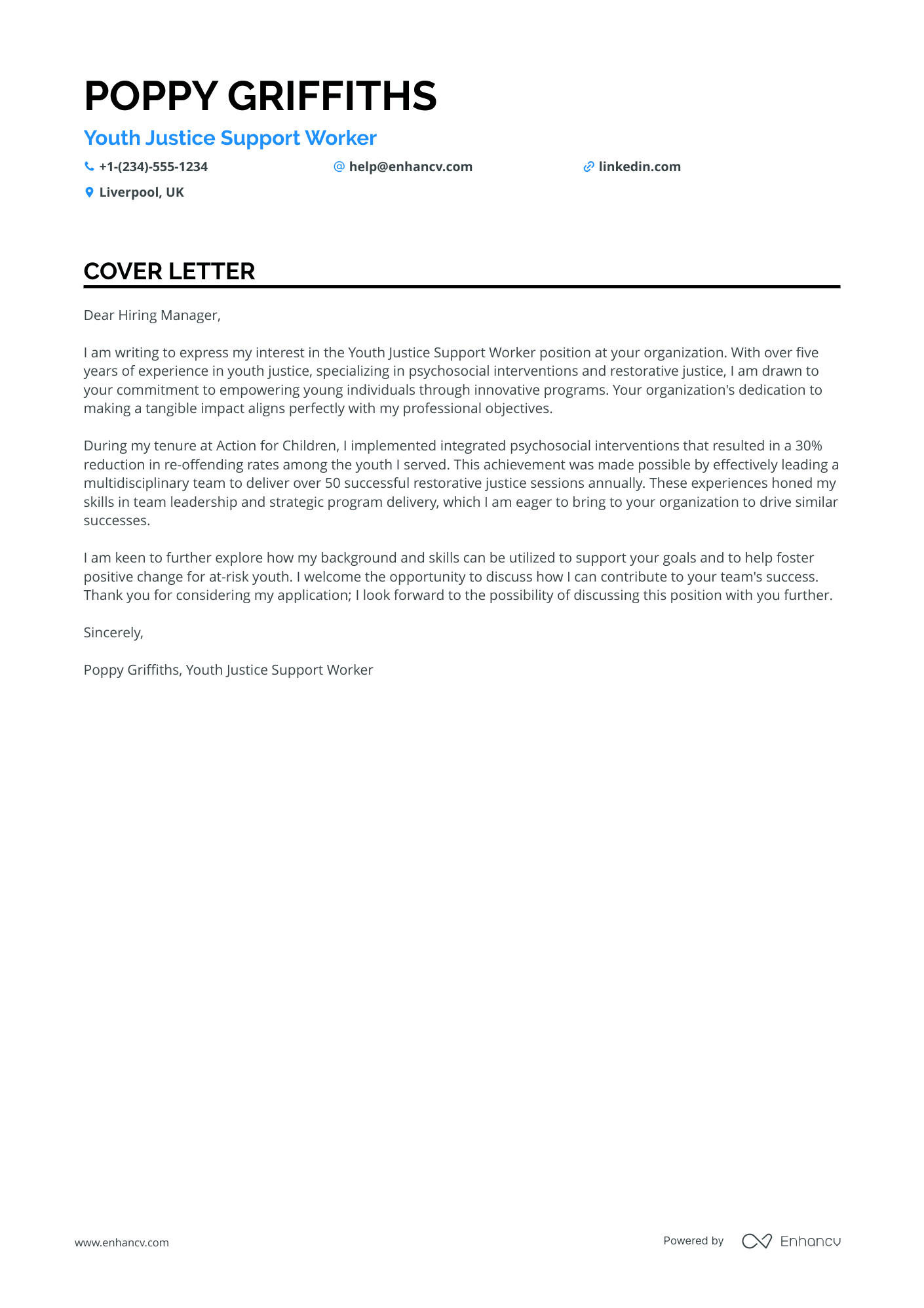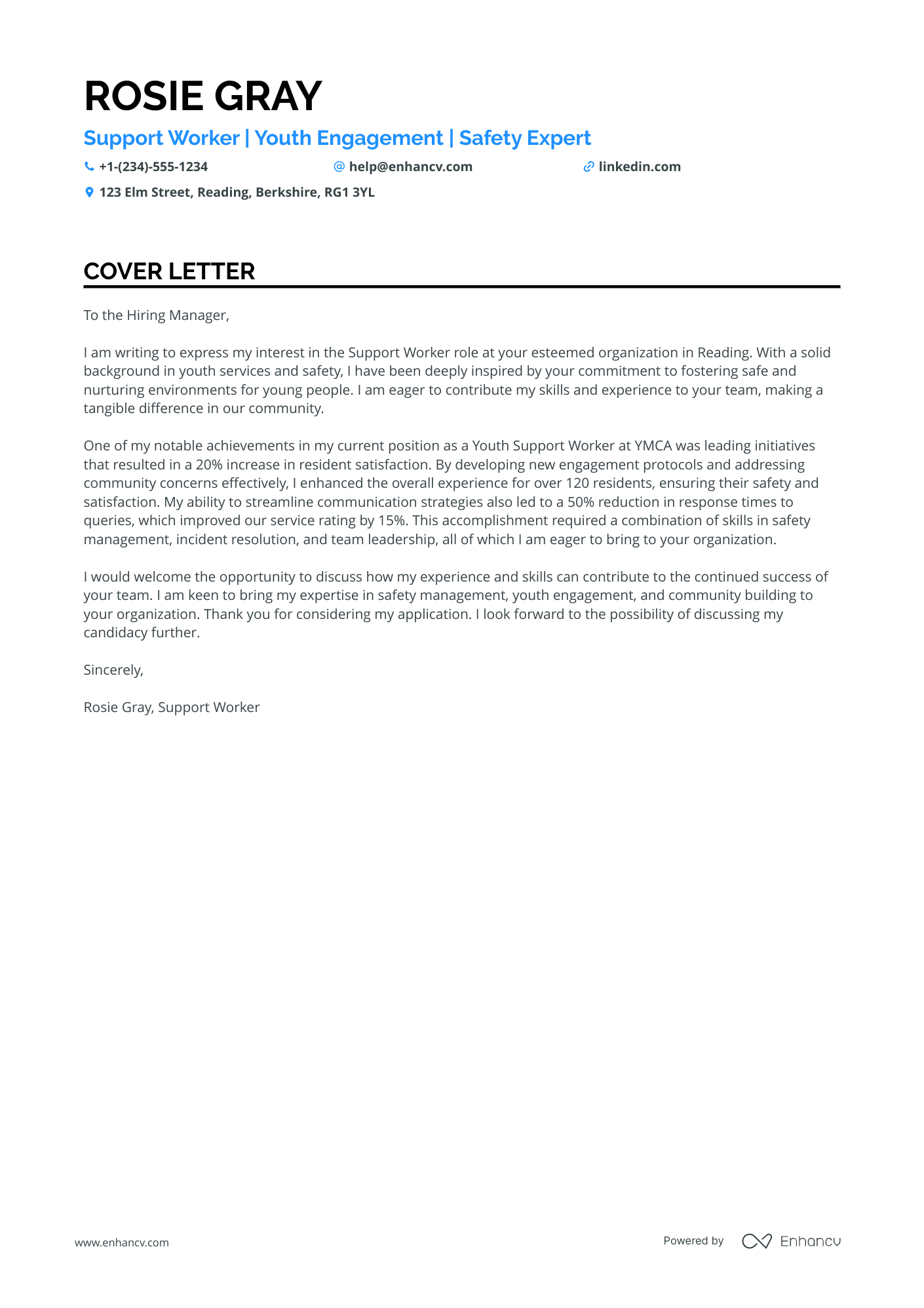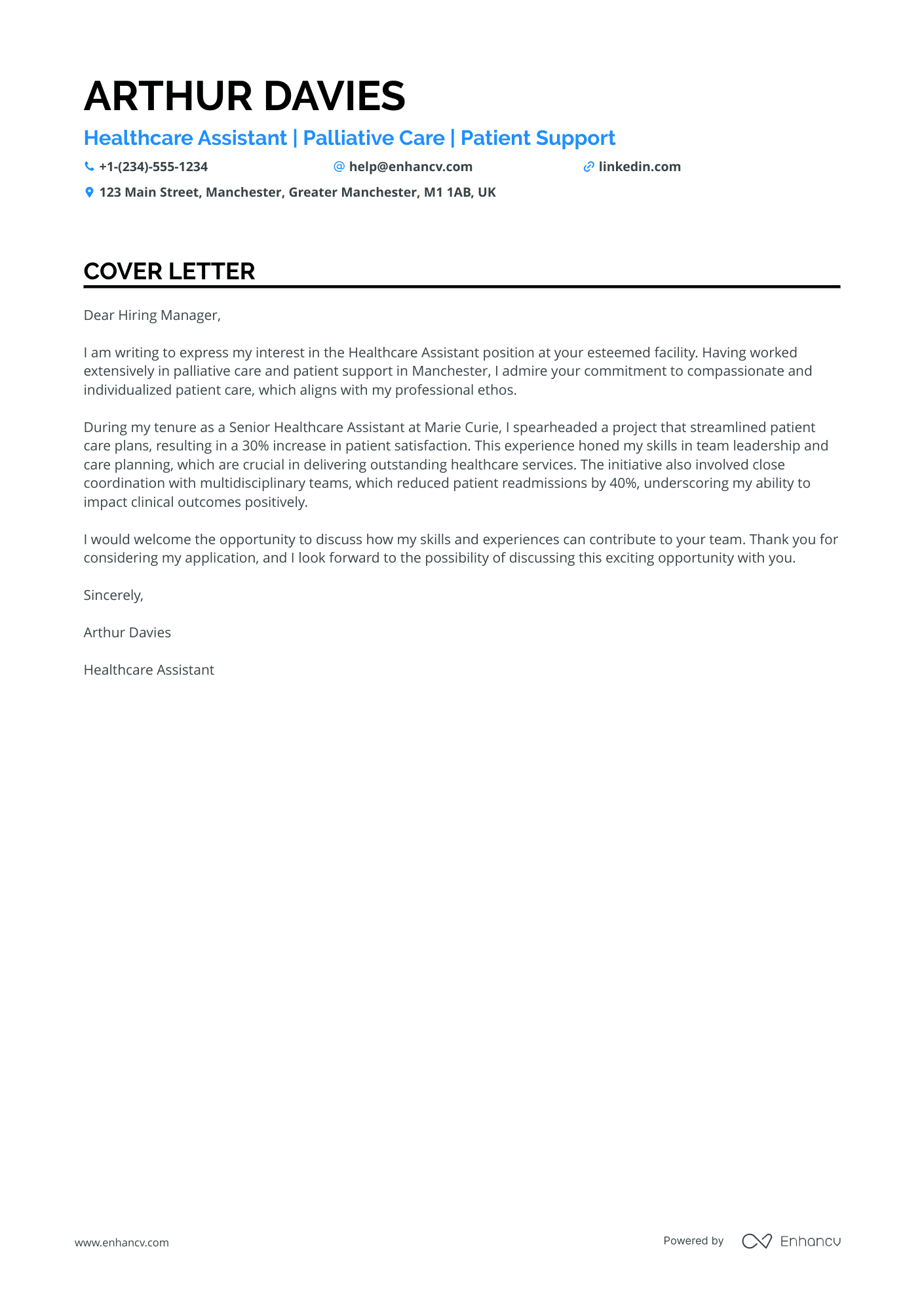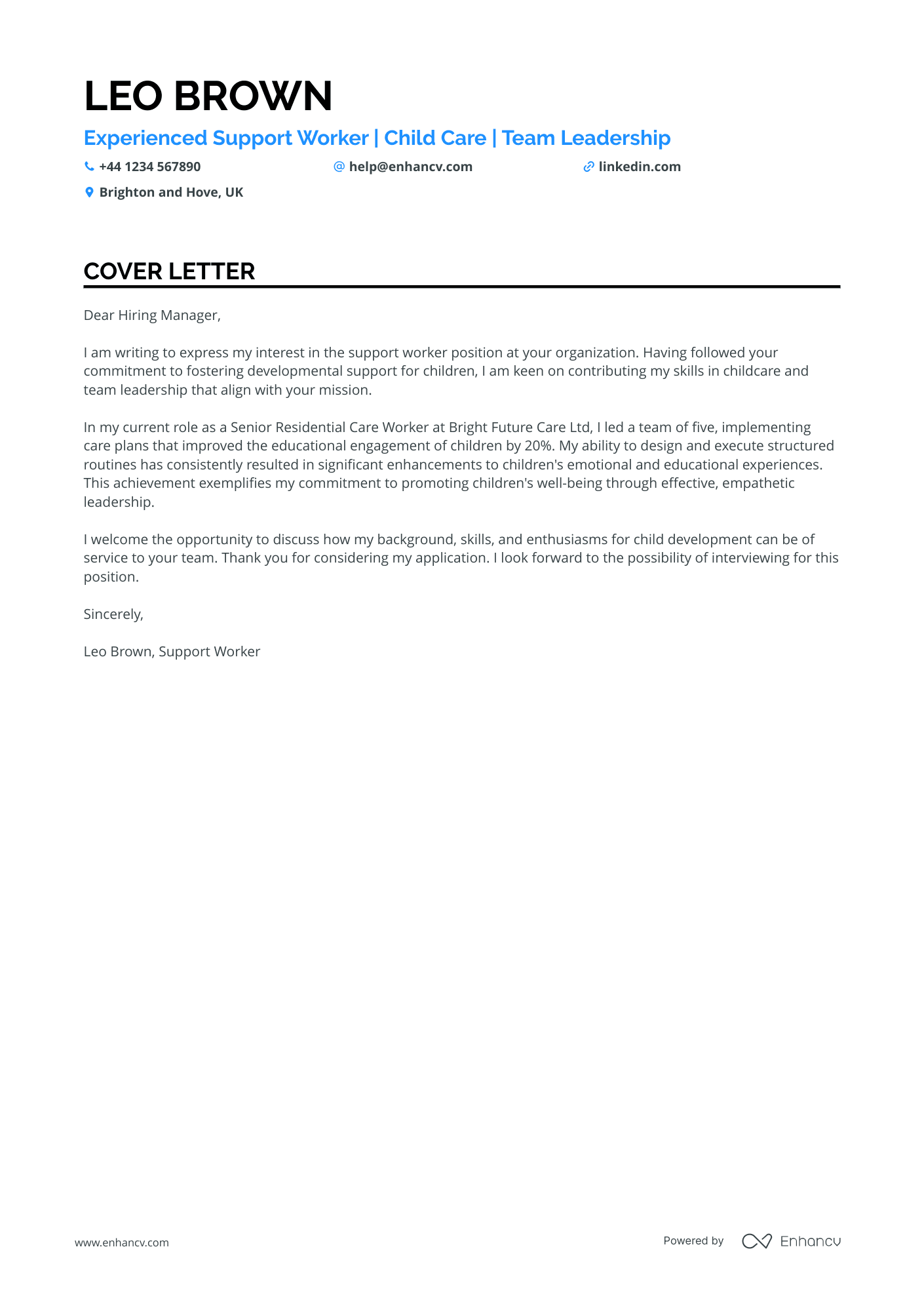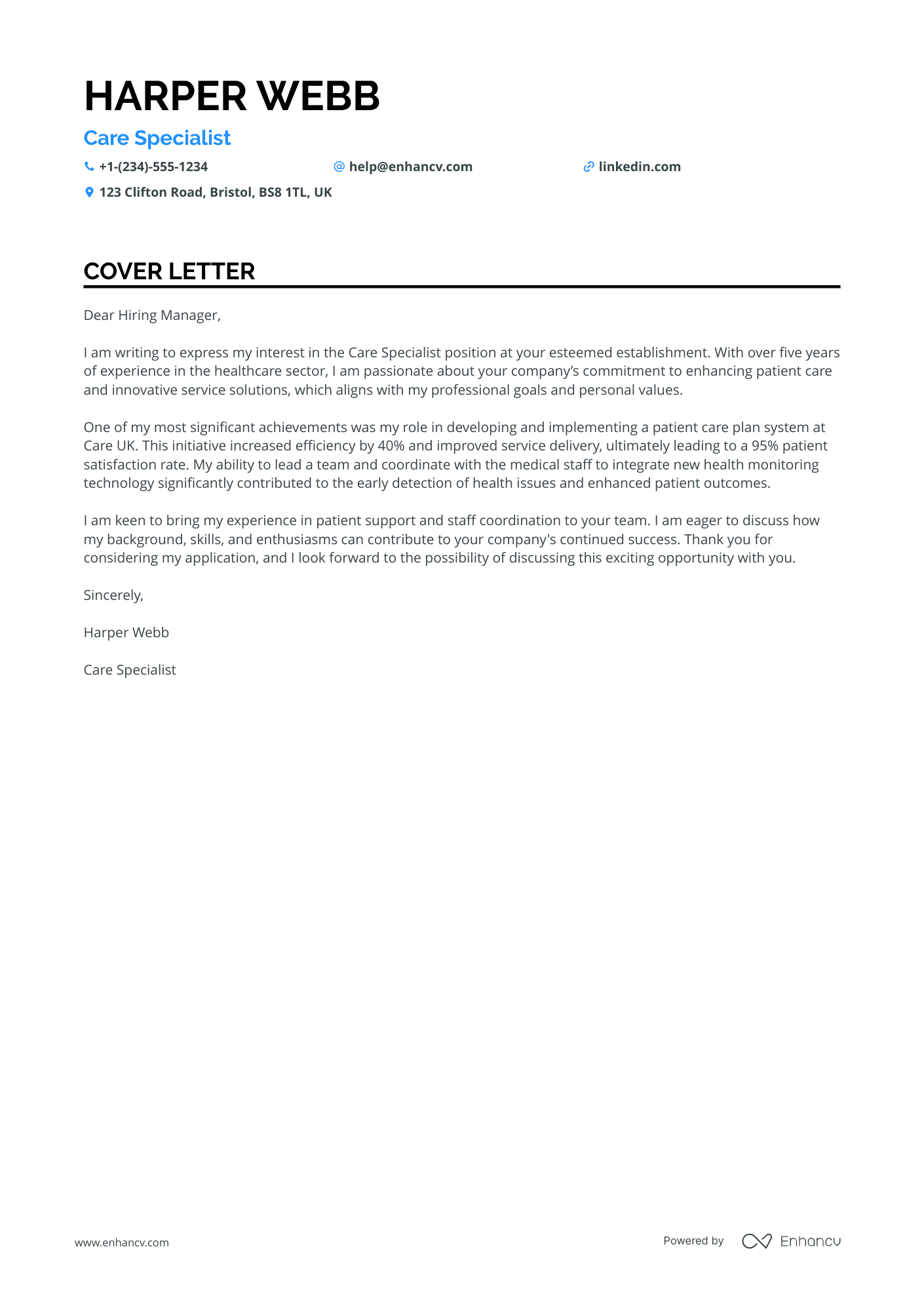You’ve just sent the same cover letter to 60 different job roles, all beginning with “Dear Sir or Madam” and ending with 'Yours sincerely.'
Bad news: you may have just missed your chance to stand out, as generic cover letters are a very common pitfall in job applications.
Did you know recruiters typically shortlist candidates based on how well they meet the job criteria? Failing to address the key requirements can cost you the role.
In this guide, we’ll show you how to tailor your cover letter to align with the job advert or company, ensuring you showcase your value as a candidate.
Cover letter examples for support worker
By Experience
Senior Support Worker
- Emphasise the significance of the "Advanced Support Worker Training" and "Mental Health First Aid Certification" for the Senior Support Worker role as they highlight expertise in advanced care and crisis management, crucial for complex healthcare needs.
- Highlight experience in successfully managing and improving team collaboration, which is pivotal in strengthening team dynamics and delivering superior care quality.
- Stress on the role played in community engagement and integration, demonstrating the ability to promote social interactions and foster a supportive community environment.
- Underscore achievements in creating and implementing care and training strategies that boost care quality and team proficiency, reflecting strong problem-solving and leadership skills.
Senior Residential Support Worker
- Emphasising achievements such as a 20% improvement in team efficiency and a 30% decrease in behavioural incidents highlights effectiveness in managing and improving residential support environments.
- The mention of specific skills such as Care Plan Development and Team Leadership showcases the candidate's ability to lead and organise support for children with various behavioural challenges.
- Including courses like Advanced Childcare Practice and Safeguarding and Child Protection demonstrates commitment to continuous professional development and expertise in essential childcare practices.
- Highlighting a Master's in Social Work from a reputable institution underpins the candidate's educational background, enhancing credibility and suitability for a senior role in residential childcare.
By Role
Community Support Worker
- Highlight the "Mental Health First Aid Certification" as specialised training relevant to roles in mental health and social care.
- Emphasise the "Enhanced Client Engagement" achievement which demonstrates the ability to effectively design and implement support strategies that increase client participation.
- Focus on the proven track record of "Efficiency in Crisis Response," showcasing the capacity to manage emergency situations and enhance trust in services provided.
- Include experience in "Community Engagement" and "Client Relationship Building," crucial skills for a Community Support Worker to foster partnerships and rapport with clients and their families.
Residential Support Worker
- Highlighted Experience: The cover letter effectively emphasises the candidate's substantial experience in emotional support and community integration, showcasing their ability to enhance young people's well-being and independence.
- Specific Achievements: The letter includes quantifiable achievements such as a 50% reduction in behavioural incidents through a mentoring programme, demonstrating the candidate's impact in previous roles.
- Relevant Certifications: It appropriately mentions specialised certifications, such as the Certificate in Therapeutic Child Care and the Autism Awareness Diploma, highlighting specialised knowledge and practical skills relevant to the role.
- Passion and Dedication: The inclusion of personal passions like child development and community engagement adds a personal touch, indicating genuine interest and commitment to the field.
Mental Health Support Worker
- Emphasising relevant professional experience by detailing specific achievements, such as enhancing service engagement by 20% and reducing client relapse rates by 15%, to showcase the impact and effectiveness in similar roles.
- Highlighting education and continuous professional development, such as a Master's in Social Work and courses in Cognitive Behavioural Therapy and Mental Health First Aid Training, indicating dedication to ongoing learning and expertise in the field.
- Showcasing leadership and teamwork skills through examples like leading a team to increase efficiency by 30% and coordinating 24/7 support services, which underscores the applicant's ability to manage and improve service delivery.
- Focusing on client-centred skills and achievements, like implementing person-centred Recovery Plans and achieving 95% client satisfaction, to demonstrate a strong commitment to client empowerment and personalised care.
Children's Support Worker
- Emphasise Relevant Experience: Highlighting over 5 years of experience in the field and specific achievements, such as improving client outcomes and youth engagement, shows competence and results-driven performance.
- Education Alignment: Mentioning a Master of Social Work and a Bachelor of Psychology outlines a strong educational foundation relevant to roles in support work and childcare.
- Advanced Certifications: Including a specific certification like the NSPCC's Advanced Child Protection demonstrates a commitment to safeguarding, crucial in childcare and residential settings.
- Showcase Leadership and Team Development: Providing examples of team leadership and enhancing team competence boosts credibility in managing and motivating a team effectively.
Learning Disabilities Support Worker
- Highlighting Leadership and Operational Impact: The cover letter underscores the candidate's experience in managing teams and improving operational efficiency, showcasing leadership qualities crucial in healthcare settings.
- Showcasing Specific Achievements: Specific achievements, such as improving patient satisfaction scores and reducing emergency response times, are highlighted, providing tangible evidence of the candidate's impact in previous roles.
- Emphasising Multidisciplinary Collaboration: The mention of collaboration with multidisciplinary teams highlights the candidate's ability to work effectively across different healthcare disciplines, which is essential for patient-centred care.
- Focus on Continuous Professional Development: Listing courses and certifications demonstrates the candidate's commitment to professional growth and staying updated with the latest healthcare advancements, which is vital in the ever-evolving healthcare sector.
Support Worker in Elderly Care
- Highlight relevant experience: Emphasise Charlotte's over 5 years of experience in care and support roles, which is crucial for demonstrating expertise and reliability in the care sector.
- Showcase achievements: Discuss specific accomplishments such as improving care plan adherence by 25% and increasing resident participation by 40%, which reflect Charlotte's ability to enhance service delivery and patient satisfaction.
- Mention specialised skills: Point out skills aligned with the role, such as understanding CQC requirements, emergency response, and risk assessment, which are essential for ensuring compliance and safety in care settings.
- Include professional development: Refer to completed courses like Safeguarding Adults Level 3 and Mental Health First Aid, highlighting commitment to continuous improvement and expertise in handling vulnerable populations.
Support Worker in Home Care
- Highlighting Relevant Certifications: The cover letter effectively mentions specialised training such as the "Advanced Dementia Care Training" and "Safeguarding Vulnerable Adults Certification," crucial for roles involving elderly care and ensuring high standards of safety and compassionate care.
- Emphasising Key Achievements: The cover letter uses specific figures like a 30% improvement in resident satisfaction and a 40% reduction in response times, illustrating the candidate's impact and effectiveness in previous roles, which is attractive for future employers.
- Showcasing Leadership and Collaboration Skills: Mentioning the supervision of a team of junior support workers and collaboration with multidisciplinary teams highlights critical leadership and teamwork abilities valuable in healthcare settings.
- Demonstrating Passion and Soft Skills: The inclusion of personal passions such as "Elderly Care Advocacy" and "Gardening" can effectively showcase the candidate’s empathy and dedication to improving living conditions for residents, aligning with a patient-centred approach.
Substance Misuse Support Worker
- Highlighting Key Achievements: The cover letter effectively showcases notable accomplishments, such as increasing recovery outcomes by 40% and securing a 20% funding increase, which are crucial for demonstrating impact and success in the field of mental health and substance abuse support.
- Relevancy of Certifications: The inclusion of relevant certifications like the Certificate in Drug and Alcohol Counselling and Mental Health First Aid Certification highlights specialised expertise, establishing credibility and suitability for the role.
- Demonstrating Client-Focused Skills: Emphasising personalised treatment plans and client satisfaction improvements showcases the candidate's client-centred approach, an essential focus for roles in mental health and substance abuse support.
- Emphasising Collaboration and Advocacy: Detail on participation in inter-agency forums and collaboration with multidisciplinary teams underlines the candidate’s advocacy and teamwork skills, critical for driving systemic improvements and comprehensive care in this field.
Support Worker in Rehabilitation Services
- Relevant Experience Highlight: The cover letter effectively showcases over five years of experience in the field, detailing specific roles and accomplishments that align with the support worker role, such as coordinating care with a Multi-Disciplinary Team and organising community outings.
- Relevant Education and Courses: It underlines the educational background with a Master’s degree in Health and Clinical Psychology and additional courses like 'Introduction to Brain Injury Rehabilitation,' indicating a strong foundation for a brain injury support worker role.
- Achievement Focus: The letter highlights key achievements, such as developing a Resident Engagement Program and creating a New Staff Training Module, demonstrating a commitment to improving both resident experiences and operational efficiencies.
- Language Proficiency: Mentioning proficiency in English and Spanish indicates the ability to communicate effectively with a broader range of clients and families in a support worker role, which could be valuable in diverse settings.
Family Support Worker
- Highlighting the "Master of Social Work" degree from the University of Edinburgh emphasises a strong academic foundation essential for a Family Support Worker role.
- Emphasising the "Effective Family Engagement Strategies" course from The Open University showcases a commitment to innovative family support approaches.
- Detailing specific achievements, such as a 30% increase in program retention and a 25% improvement in school attendance, demonstrates measurable success in the applicant's previous roles.
- Showcasing crisis intervention skills, with a 15% reduction in family stress, provides evidence of the ability to manage and improve challenging situations effectively.
Support Worker in Youth Services
- Highlight the "Restorative Justice Practitioner Certificate" as it underscores specialised training relevant to the role, showcasing expertise in reconciliation techniques.
- Emphasise the measurable impact of work experience such as "30% reduction in re-offending rates," as it demonstrates strategic effectiveness and real-world success in behavioural change.
- Showcase leadership and collaboration skills by detailing experiences of leading multidisciplinary teams and coordinating with local services, which are critical for a Youth Justice Support Worker.
- Leverage the "Significant Offending Reduction" achievement and awards like the "Award for Outstanding Team Leadership" to bolster credibility and highlight proven competency in the field.
Autism Support Worker
- Highlight specific skills and certifications relevant to the role, such as Positive Behaviour Support and Autism and Mental Health Awareness, to demonstrate proficiency and alignment with job requirements.
- Provide concrete examples of achievements, like leading a team to a 25% increase in independent skills among individuals with Autism, to illustrate impactful experience.
- Focus on community engagement and risk management as key aspects of previous roles, showcasing the ability to enhance community involvement and maintain high compliance levels.
- Emphasise leadership and training development, such as increasing team certification rates by 20%, to demonstrate capability in improving organisational practices and outcomes.
Domiciliary Support Worker
- Emphasising leadership skills through reductions in patient incidents and improved training programmes, which are vital for a Care Specialist role.
- Highlighting the implementation of systems and technologies, such as patient care plans and digital scheduling, which showcases an ability to enhance efficiency and service delivery.
- Showcasing a Master of Science in Health and Social Care as a further educational qualification, enhancing credibility in patient support roles.
- Detailing achievements in community outreach and volunteer engagement, reflecting strong community-oriented focus that aligns well with patient and family support objectives.
Floating Support Worker
- Relevant Experience: The cover letter effectively highlights over two years of experience in housing and welfare, emphasising substantial improvements in tenancy stability and community engagement.
- Specific Achievements: The applicant details specific achievements, such as reducing incidents of tenancy challenges by 30% and decreasing emergency housing admissions by 15%, demonstrating their impact in previous roles.
- Expertise in Substance Misuse: The candidate's expertise in managing complex cases involving substance misuse and a 25% recovery rate among participants is clearly identified, showcasing their proficiency in a specialised area within mental health support.
- Educational Background: The inclusion of a Bachelor of Science in Psychology and a Master of Social Work highlights a strong educational foundation, essential for a Mental Health Support Specialist role.
Night Support Worker
- Highlighting Experience in Youth Services: The cover letter effectively emphasises Rosie's extensive experience in youth engagement roles, emphasising her capacity to enhance resident satisfaction and ensure safety through a detailed account of her professional history.
- Emphasising Proven Safety Management Success: Rosie underscores specific accomplishments such as a 25% reduction in safety violations through audits, which demonstrates her expertise and proactive approach in safety management and incident reduction.
- Demonstrating Leadership and Training Abilities: The letter details Rosie's ability to lead teams and improve operational protocols, evidenced by her success in training recruits and devising new engagement protocols, leading to significant boosts in performance metrics and team efficiency.
- Showcasing Relevant Certifications and Training: The inclusion of specialised courses like the Crisis Intervention Workshop and Advanced Safeguarding Practices underscores Rosie's commitment to continuous professional development and her equipped knowledge to handle crises efficiently.
Support Worker in Palliative Care
- Highlighting the NVQ Level 2 Care qualification is crucial for a healthcare assistant role, demonstrating specialised training and expertise.
- Emphasising experience in managing teams and implementing care plans showcases leadership and organisational skills, critical for advancing in palliative care roles.
- Showcasing the successful implementation of patient care projects, such as the 30% increase in patient satisfaction, illustrates a proven track record in enhancing patient outcomes.
- Incorporating specific achievements, like the award for exceptional patient care, provides third-party validation of dedication and effectiveness in the role.
Support Worker in Social Care
- Highlighting Specialist Experience: Emphasise expertise in "Adoption Support" and "Crisis Management" roles, as this aligns directly with the specialisation required for the role.
- Quantifying Achievements: Use specific numbers and statistics, such as improving permanency rates by 25% and decreasing disruptions by 20%, to demonstrate effectiveness in previous roles.
- Relevant Skills and Courses: Showcase critical skills such as "Family Support" and "Service Documentation," backed by relevant courses like “Advanced Crisis Intervention” to validate expertise in crisis management and family dynamics.
- Demonstrated Leadership and Innovation: Cite experience in leading teams, implementing pilot programmes, and developing outreach strategies to underscore leadership capabilities and innovative thinking.
Support Worker in Special Needs Schools
- Highlighting Expertise in SEN Support: Emphasise extensive experience and education in Special Educational Needs to showcase capability for specialised roles in this field.
- Incorporating Quantifiable Achievements: Use specific statistics to demonstrate impact, such as increasing student engagement by 25%, to provide empirical evidence of effectiveness.
- Utilising Technology in Education: Emphasise skills in ICT for education, reflecting a modern approach to enhancing student learning and engagement.
- Strong Communication Skills: Highlight achievements in improving parent-teacher communication and interaction among students, which are crucial in educational environments.
Support Worker cover letter example
Leo Brown
Brighton and Hove, UK
+44 1234 567890
help@enhancv.com
- Alignment with Organization's Mission: The cover letter effectively emphasizes the applicant's understanding and enthusiasm for the organization's mission, which is crucial in roles centered on child development and care.
- Demonstrating Leadership and Measurable Impact: By highlighting their leadership of a team and a tangible achievement (20% improvement in educational engagement), the applicant showcases both leadership skills and a focus on achieving measurable outcomes, which are valuable traits for support roles.
- Commitment to Child Development: The letter showcases a deep commitment to child development through empathetic leadership and the creation of structured routines that positively impact children's emotional and educational experiences.
- Call to Action: Ending the letter with a clear call to action invites further communication, demonstrating enthusiasm and professionalism, which are appealing attributes to hiring managers in this field.
Importance of cover letters in the United Kingdom
Cover letters provide recruiters with the opportunity to learn more about your career aspirations, hinting at how you’d integrate within the organisation over the long term.
Here are three additional reasons why cover letters are important:
- Making an excellent first impression (and a formal introduction): Your cover letter is often the employer’s first introduction to you, showcasing your personality, communication skills, and motivation for the role.
- Complementing your career history: While your CV lists qualifications and experience, a cover letter provides the context, explaining how your background fits the role.
- Demonstrates your genuine interest: A well-crafted cover letter reflects the effort you’ve put into researching the company and role as well as your attention to detail.
What UK employers expect from a cover letter
A great cover letter can set you apart when applying for jobs in the UK.
Follow these tips to ensure you make a strong impression:
- Research thoroughly: Spend time delving into the company’s website, social media, and industry news to understand their projects, awards, and future plans. The more specific your knowledge, the better you’ll be able to demonstrate your suitability for the role.
- Reflect their values: Every UK company has its own set of values that guides their culture. Once you’ve identified them, make sure your cover letter reflects how your values and work ethic align with theirs. If they’re known for integrity, emphasise your commitment to ethical practices.
- Tailor your skills: Focus on aligning your most relevant skills with the job description. Look for key terms and priorities mentioned in the advert, and make sure to provide examples of how you excel in those areas.
How to format a support worker cover letter
Your cover letter is your opportunity to make a strong impression, so its structure must be professional and clear.
Here's an overview of how a UK cover letter should be structured:
- Begin with your address and contact details at the top.
- Include the employer’s name and address directly below.
- Add the date to the left or right of the page.
- Use an appropriate greeting, such as 'Dear Mr Smith' or 'Dear Sir/Madam.'
- Open with a strong introductory paragraph.
- Develop your points in the middle paragraphs, focusing on relevant skills and experience.
- Close with a concise conclusion, reiterating your interest and suitability for the role.
- Sign off formally with your name and signature.
The software used to match your profile to the job, Applicant Tracking Systems (ATS), won’t scan your cover letter. Instead, the cover letter reads as a more personalised note to the recruiter.
When it comes to choosing a font, consider modern options like Lato, Rubik, or Chivo, which should also be applied to your CV to maintain a consistent appearance.
Additionally, your cover letter should be single-spaced with 1-inch (2.5 cm) margins on all sides (our templates are pre-set with these specifications so you can focus on your cover letter content).
Finally, always send your cover letter as a PDF to preserve the formatting and prevent edits.
How to write your support worker cover letter salutation
Imagine you're a hiring manager reading through countless cover letters—which would catch your attention: being addressed directly by name, or reading 'Dear Sir or Madam'?
The first option shows you've made the effort to learn about the company and the role.
To find the hiring manager's name, try LinkedIn, check the company's website, or even reach out to the organisation on social media.
How to write your support worker cover letter intro
A great option to begin your cover letter is by showing recruiters you've done your homework or research.
If the company has won an award or made headlines, congratulate them in your opening sentence, or express how impressed you are.
Provide this achievement as a reason why you admire the company, ensuring your tone remains genuine, sincere, and authentic.
How to write your support worker cover letter body
As you reach the body of your cover letter, you might wonder what to write in it.
Our advice? Don’t just copy your CV—choose your greatest achievement and tell its story.
Focus on how you got there using hard and soft skills, describe your involvement, and quantify the results with concrete outcomes.
Remember, recruiters aren’t looking for an epic tale of your career—they want something concise, relevant, and directly addressing their needs.
How to write a closing paragraph
Looking to leave a lasting impression with your cover letter closing?
Then, you should certainly end with a promise—one that outlines what you aim to achieve in the role. Ensure your goals are realistic and align with the company’s needs.
You might also include a call to action, enquiring when you can expect to hear back and what the next steps in the hiring process will be.
Conclusion
Creating a compelling cover letter is vital in making a positive first impression on potential employers. Personalise your letter by addressing the hiring manager directly and ensuring your skills align with the job description.
Highlight specific achievements that demonstrate your suitability for the role, and express genuine enthusiasm for the opportunity. Finally, maintain a professional format that complements your CV for a cohesive application.












